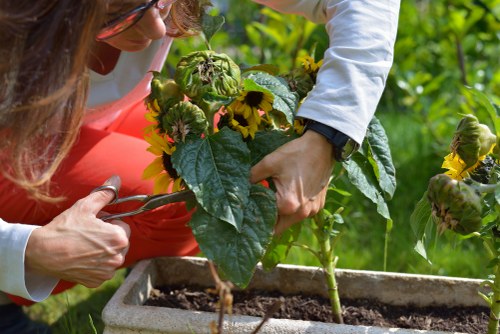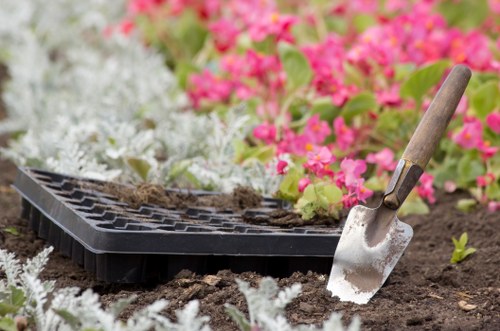Hedge Trimming in Temple: Enhancing Sacred Spaces
Introduction to Hedge Trimming in Temples

Hedge trimming in temples is a vital practice that combines horticultural skill with spiritual significance. Temples, as places of worship and meditation, often feature intricate landscaping that requires regular maintenance to preserve their beauty and sanctity.
Proper hedge trimming not only maintains the aesthetic appeal of temple grounds but also symbolizes the cultivation of spiritual growth and discipline. The meticulous care taken in shaping hedges reflects the dedication of the community to maintain their sacred spaces.
The process of hedge trimming in temples involves understanding the specific botanical needs of various plants, as well as the cultural and religious symbolism attached to them. This ensures that the trimming practices align with both the natural requirements of the plants and the spiritual values of the temple.
The Importance of Hedge Maintenance

Maintaining hedges in temple environments serves multiple purposes. Firstly, it enhances the visual beauty of the temple, making it more inviting for devotees and visitors. Well-trimmed hedges contribute to a serene and peaceful atmosphere, ideal for contemplation and prayer.
Secondly, hedge maintenance plays a role in the ecological balance of the temple grounds. Properly managed hedges provide habitat for various forms of wildlife, encouraging biodiversity and promoting a healthy ecosystem.
Additionally, regular trimming prevents overgrowth that can obscure pathways, entrances, and sacred symbols within the temple grounds. This ensures that the focus remains on the spiritual elements of the temple rather than the surrounding vegetation.
Techniques for Effective Hedge Trimming

Effective hedge trimming in temples requires a blend of traditional techniques and modern horticultural practices. The goal is to achieve symmetrical shapes that complement the architectural elements of the temple while ensuring the health and vitality of the plants.
One common technique is the use of clean, sharp tools to make precise cuts. This minimizes damage to the plants and promotes faster healing, reducing the risk of disease and pest infestation.
Another important aspect is the timing of trimming. Performing hedge trimming during the plant’s dormant season or early spring can result in healthier growth and more defined shapes. It is essential to understand the growth patterns of different hedge species to determine the optimal trimming schedule.
Tools and Equipment for Hedge Trimming

Having the right tools is crucial for effective hedge trimming. Common tools include hedge shears, pruning saws, loppers, and electric trimmers. Each tool serves a specific purpose and is chosen based on the type and size of the hedges being maintained.
Hedge shears are ideal for shaping and trimming small to medium-sized hedges, providing clean and uniform cuts. Pruning saws are used for larger or thicker branches that shears cannot handle effectively.
Electric trimmers offer efficiency and ease of use, especially for extensive temple grounds. They allow for quick trimming of large areas, reducing the time and labor involved in maintaining the hedges.
Choosing the Right Plants for Temple Hedges

Selecting appropriate plant species is fundamental to successful hedge trimming in temples. Plants should be chosen based on their growth habits, durability, and symbolic significance within the temple’s cultural context.
Commonly used species include boxwood, yew, privet, and holly, each offering different textures and shapes that can be tailored to the temple’s aesthetic requirements. Additionally, native plants are often preferred as they are better adapted to the local climate and soil conditions, ensuring lower maintenance needs and greater resilience.
The symbolic meaning of plants also plays a role in their selection. Many temples incorporate plants that represent specific spiritual concepts, such as longevity, purity, and harmony, thereby enriching the sacred environment.
Eco-friendly Practices in Hedge Trimming
Adopting eco-friendly practices in hedge trimming is increasingly important in temple maintenance. Sustainable methods help preserve the environment while ensuring the health and beauty of the temple grounds.
One such practice is the use of organic fertilizers and natural pest control solutions. This minimizes the impact on the ecosystem and prevents the contamination of soil and water sources.
Additionally, recycling green waste generated from trimming activities contributes to sustainability. Composting trimmed plant material can provide valuable nutrients back to the soil, promoting healthier plant growth.
Water Conservation Techniques
Water conservation is another critical aspect of eco-friendly hedge maintenance. Implementing efficient irrigation systems, such as drip irrigation, ensures that hedges receive the necessary moisture without excessive water usage.
Integrated Pest Management
Integrated pest management (IPM) strategies involve monitoring and managing pests in an environmentally responsible manner. This approach reduces reliance on chemical pesticides, promoting a healthier ecosystem within the temple grounds.
The Role of Hedge Trimming in Temple Symbolism
Hedge trimming in temples is not merely a maintenance task; it holds deep symbolic meaning. The act of shaping hedges mirrors the spiritual journey of refinement and growth, reflecting the inner transformation sought by devotees.
Symmetrical and orderly hedges embody harmony and balance, concepts central to many religious practices. The precise lines and forms achieved through trimming represent the disciplined path towards enlightenment and spiritual clarity.
Moreover, certain designs and patterns in hedge trimming can hold specific cultural or religious significance, enhancing the sacredness of the temple environment.
Symbolic Shapes and Patterns
Incorporating symbolic shapes, such as lotus petals or concentric circles, into hedge trimming can reinforce the spiritual themes of the temple. These patterns serve as visual reminders of core beliefs and values, enriching the devotional experience for visitors.
Cultural Significance of Plant Species
The choice of plant species for temple hedges often reflects cultural traditions and religious narratives. For example, the use of bamboo in certain cultures symbolizes strength and flexibility, while jasmine may represent purity and devotion.
Seasonal Hedge Trimming Practices
Seasonal variations significantly influence hedge trimming practices in temples. Each season presents unique challenges and opportunities for maintaining the health and appearance of hedges.
During spring, trimming encourages new growth and helps shape the hedges before the peak growing season. Summer trimming focuses on controlling growth and maintaining desired shapes under warmer conditions.
Autumn trimming prepares hedges for the dormant winter months, reducing the risk of damage from harsh weather and ensuring that plants are well-maintained for the following year.
Spring Maintenance Tips
In spring, it is essential to remove any dead or damaged branches that may have accumulated during winter. This allows the plant to direct its energy towards healthy new growth.
Winter Preparations
Before winter sets in, hedge trimming involves insulating the plants by removing excess foliage that could be damaged by frost. This practice helps protect hedges and promotes resilience against cold temperatures.
Professional Hedge Trimming Services for Temples
Engaging professional hedge trimming services ensures that temple hedges are maintained to the highest standards. Professionals bring expertise in both horticulture and the specific requirements of sacred spaces, ensuring that trimming practices align with the temple’s spiritual and aesthetic needs.
Professional services offer comprehensive maintenance plans, including regular trimming schedules, plant health assessments, and tailored trimming techniques. This proactive approach prevents overgrowth and maintains the hedges in optimal condition throughout the year.
Additionally, professionals are equipped with the necessary tools and knowledge to handle various hedge species, ensuring that each plant receives the appropriate care and attention.
Benefits of Hiring Experts
Hiring experts for hedge trimming provides several benefits, including time savings, consistent quality, and access to specialized knowledge. Experts can identify and address potential plant health issues early, preserving the longevity and beauty of the hedges.
Customized Maintenance Plans
Customized maintenance plans cater to the unique needs of each temple, accommodating specific plant types, growth rates, and aesthetic preferences. This personalized approach ensures that hedge trimming enhances the overall harmony and sanctity of the temple grounds.
Community Involvement in Hedge Trimming
Involving the temple community in hedge trimming fosters a sense of ownership and collective responsibility for maintaining sacred spaces. Volunteer trimming days can be organized, allowing devotees to contribute to the upkeep of the temple gardens.
Community involvement not only reduces maintenance costs but also strengthens the bond among members, promoting a shared commitment to preserving the temple’s beauty and spiritual ambiance.
Educational workshops on basic hedge trimming techniques can empower community members to participate more effectively, ensuring that hedges are consistently maintained even between professional service visits.
Organizing Volunteer Events
Organizing regular volunteer events provides structured opportunities for community participation. These events can include training sessions, group trimming activities, and appreciation gatherings to recognize contributors’ efforts.
Educational Initiatives
Educational initiatives help spread knowledge about proper hedge trimming practices, plant care, and the symbolic importance of temple gardens. This enhances the overall maintenance quality and fosters a deeper connection between community members and their sacred space.
Challenges in Hedge Trimming for Temples
Hedge trimming in temples presents several challenges, including balancing aesthetic requirements with plant health, managing diverse plant species, and coordinating maintenance activities around religious events.
Maintaining consistent trimming schedules can be difficult due to varying growth rates of different hedge species. Additionally, ensuring that trimming practices do not disrupt temple activities or sacred rituals requires careful planning and coordination.
Climate changes and pest infestations also pose threats to hedge health, necessitating adaptive strategies and ongoing vigilance to preserve the integrity of the temple gardens.
Managing Diverse Plant Species
Temples often feature a variety of plant species, each with unique trimming needs. Effective hedge trimming requires understanding the specific growth habits and care requirements of each species to maintain their health and appearance.
Adapting to Environmental Changes
Adapting hedge trimming practices to environmental changes, such as shifting weather patterns and emerging pests, is crucial for sustaining healthy temple gardens. This may involve adjusting trimming schedules, introducing pest-resistant plant varieties, and implementing protective measures against extreme weather conditions.
Benefits of Well-Trimmed Temple Hedges
Well-trimmed hedges in temples offer numerous benefits, ranging from enhanced aesthetics to improved spiritual experiences for visitors. The orderly and beautiful hedges create a harmonious environment that supports meditation and worship.
Healthy hedges also contribute to better air quality, providing shade and cooling the temple grounds during hot seasons. This creates a more comfortable atmosphere for devotees and extends the usability of outdoor prayer areas.
Furthermore, meticulously maintained hedges reflect the temple’s commitment to excellence and care, reinforcing its reputation as a sacred and revered place of worship.
Aesthetic and Spiritual Harmony
The visual harmony achieved through well-trimmed hedges enhances the overall aesthetic appeal of the temple, creating a serene and inviting space conducive to spiritual practices.
Environmental Contributions
Healthy hedges play a role in environmental sustainability by supporting local wildlife, preventing soil erosion, and contributing to the overall green canopy of the temple grounds.
Future Trends in Hedge Trimming for Temples
The future of hedge trimming in temples is likely to embrace innovative techniques and sustainable practices. Technological advancements, such as automated trimming tools and smart irrigation systems, may enhance maintenance efficiency and precision.
There is also a growing emphasis on eco-friendly and organic trimming methods, reflecting a broader commitment to environmental stewardship. Integrating traditional trimming practices with modern sustainability principles will likely shape the evolution of temple hedge maintenance.
Additionally, the incorporation of native and resilient plant species is expected to increase, promoting biodiversity and reducing maintenance demands.
Incorporating Technology
Technology can streamline hedge trimming processes, allowing for more accurate shaping and scheduling. Tools like laser-guided trimmers and drone monitoring can ensure high-quality maintenance while reducing manual labor.
Sustainable Landscaping Practices
Sustainable landscaping practices, such as using renewable energy-powered tools and implementing water-efficient irrigation systems, will become integral to hedge trimming strategies, aligning temple maintenance with global environmental goals.
Conclusion: The Integral Role of Hedge Trimming in Temples
Hedge trimming in temples is a multifaceted practice that goes beyond mere maintenance. It embodies the harmony between nature and spirituality, reflecting the temple’s dedication to creating a sacred and serene environment.
By adopting effective trimming techniques, utilizing the right tools, and engaging the community, temples can ensure their hedges remain healthy, beautiful, and symbolically significant. Embracing sustainable practices further enhances the ecological and spiritual harmony of temple grounds.
Ultimately, well-trimmed hedges contribute to a peaceful and inviting atmosphere, enriching the spiritual experiences of all who visit the temple.
Embracing Tradition and Innovation
The balance between traditional practices and modern innovations will continue to shape the future of hedge trimming in temples, ensuring that these sacred spaces remain vibrant and spiritually conducive for generations to come.
Maintaining Spiritual Sanctity Through Care
Through diligent maintenance and thoughtful care, hedge trimming remains an essential aspect of preserving the spiritual sanctity and natural beauty of temples, fostering environments where faith and nature coexist harmoniously.
Call to Action
Ensure your temple’s gardens reflect the sanctity and beauty of your sacred space. Contact us today to schedule expert hedge trimming services tailored to your temple’s unique needs.
Ready to enhance your temple grounds? Book your service now and experience the harmony of well-maintained hedges.
